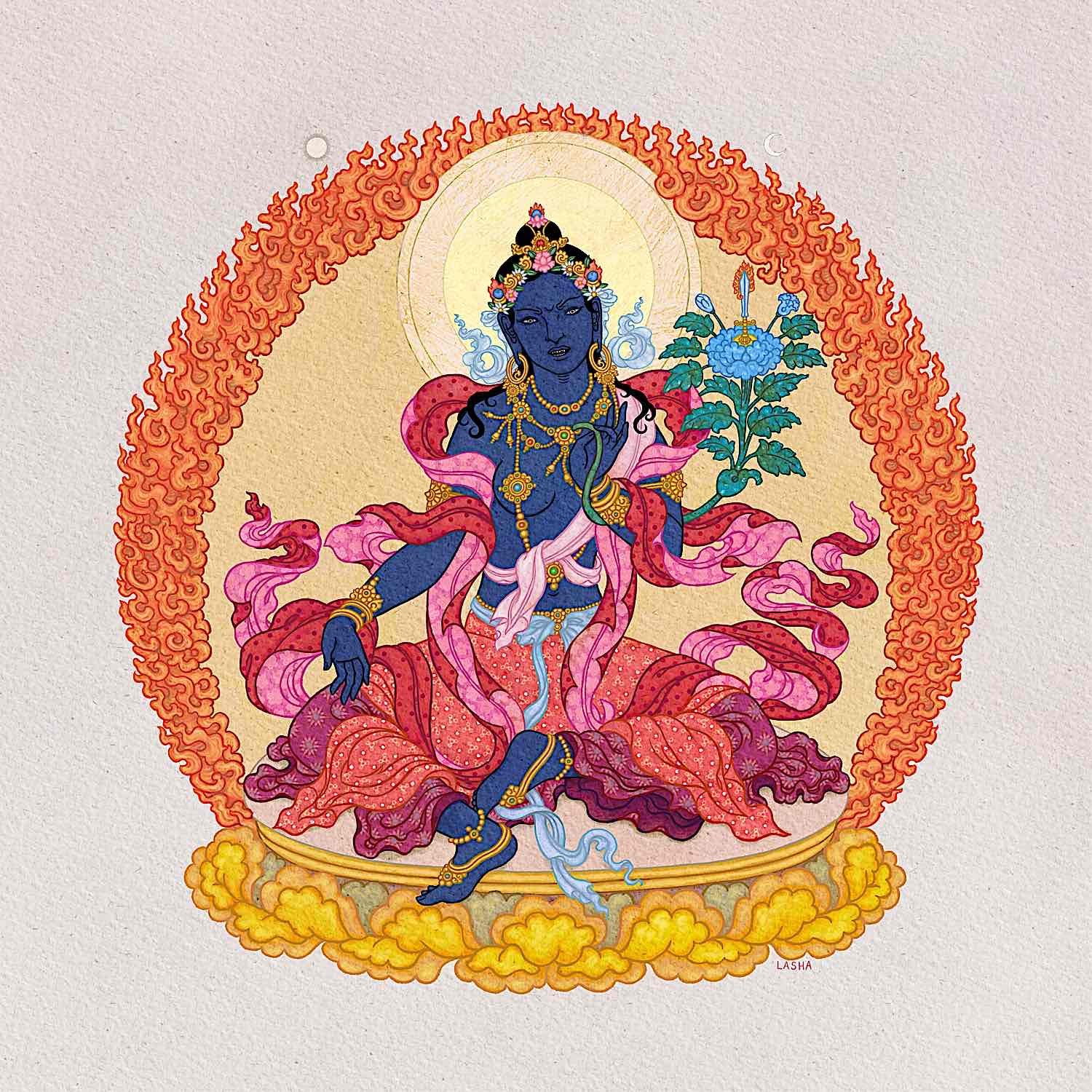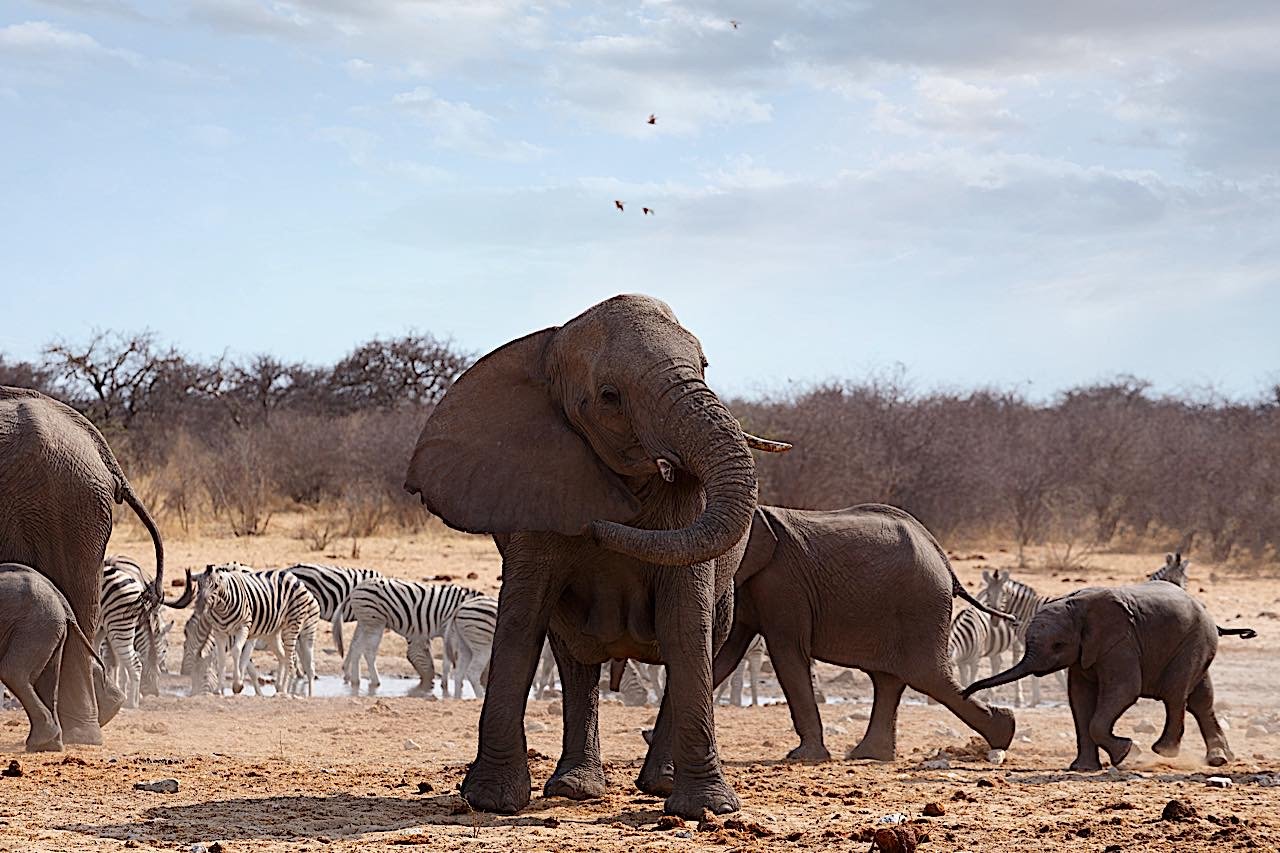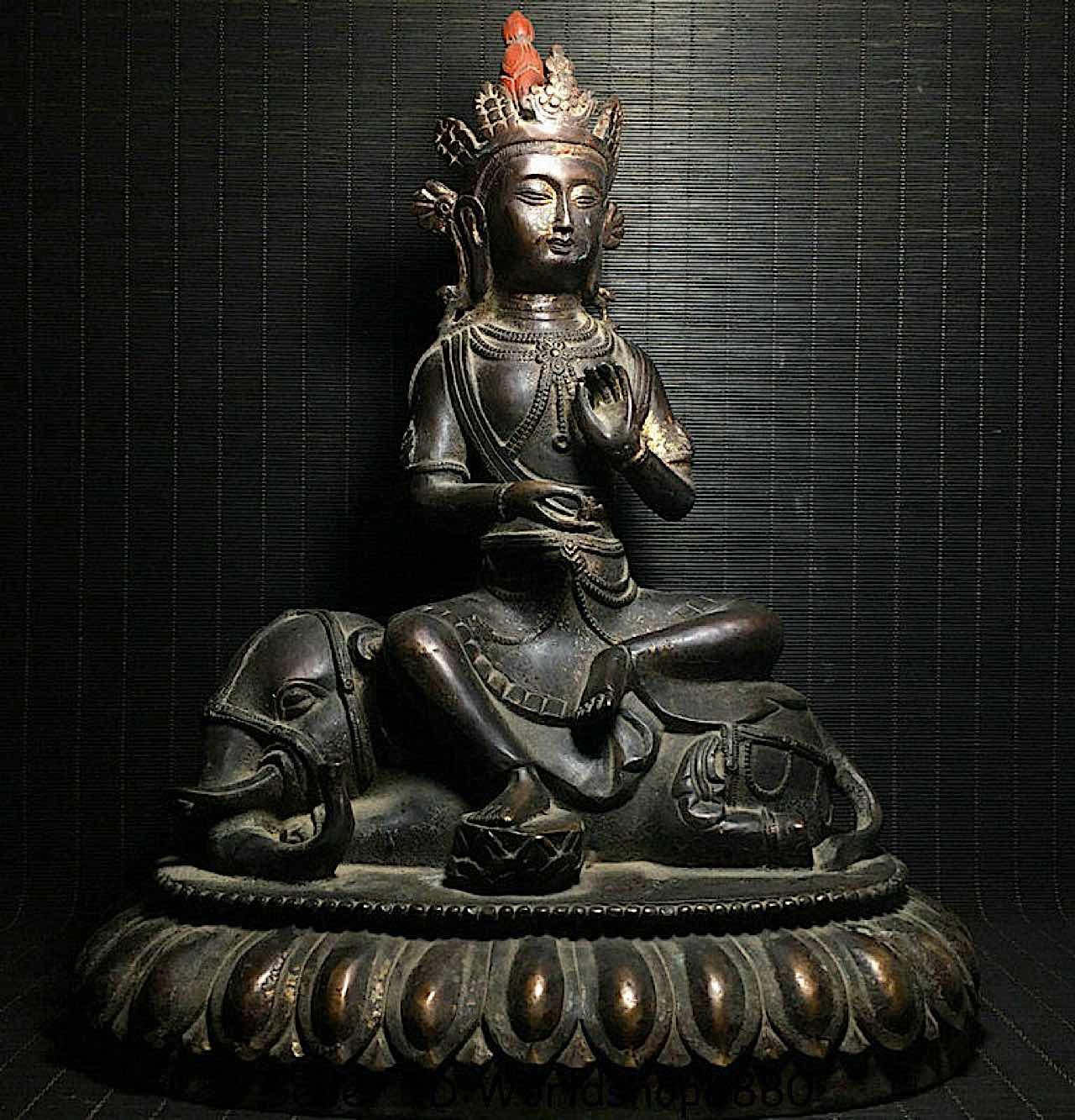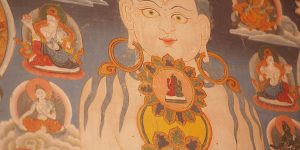Black Tara — Destroyer of Enemies and Evil, Who Protects from All Negativities and Obstacles Internal or External
Black Tara is the most approachable of the protective, wrathful Buddha emanations. She is called Tara Who Destroys all Enemies, and Tara who is Invicible. She is the 7th of the twenty-one Taras, and one of the most reassuring in times of threat, danger or attack from internal or external enemies.
Whether the enemies are internal obstacles, your anger, hate, greed, or craving, or external enemies who obstruct or threaten your life, She is like a wrathful elephant mother protecting her young.

Tara — Our Mother of Protection
Tara, our mother of protection, is already the most protective of Buddhist Enlightened Aspects. In her black form, as Black Tara, her protective wrath is so active that results are as quick as lightning.
How is this possible? Tara’s Enlightened Mind, her Pureland, is found within our minds and hearts. When we think of her, she is already there. She is one with us at the ultimate level. Saying her name or chanting her mantra instantly reminds us of the wisdom and compassion inherent in our essence.
With Tara, it can be as simple as thinking of her lovingly, saying her name, or chanting her short mantra.
Chant along in Sanskrit with Buddha Weekly:
Is Black Tara Separate from Green Tara?
Is Black Tara separate from Green Tara? The answer is no. Mother Tara emanates in countless forms to help us, as suits our needs, but all forms of Tara are still Tara. Her appearance, mantra, and energy manifest as we need it now. In the case of Black Tara, this energy is supremely wrathful and quick, like the anger of a protective mother.

Think of the elephant metaphor in Buddhism. Mother Tara is serene and calm, like a peaceful elephant, until her children are in danger. In nature, if a pride of lions threatens a baby elephant, the ordinarily calm mother elephant, without thinking of any risk, charges into their midst, protecting her baby. We are Tara’s child, and she is ready to charge into the pride of lions to protect us.
The metaphor of an elephant mother is a deliberate one. In Buddhism, the symbolism of the elephant is intelligence, calm energy, and unbelievable strength — but a mother elephant, given the right reasons, is terrible in her anger. In Tara’s cycle of teachings, she not only protects from the dangers of elephants — one of the eight dangers, which is a metaphor for ignorance — but she is often pictured riding an elephant. This shows she mastered ignorance.

Black Tara destroys causes, not life
It is important to understand that her title “destroyer of enemies” does not mean destroyer of sentient life. If you’re enemy is attacking you, she can destroy the anger and hate causing the attack, but not the attacker itself. Taking of a life is impossible for a Bodhisattva. So, if someone is “cursing you” or using “black magic” — in modern terms wishing you bad fortune — of if someone is physically attacking you, she cannot create bad karma for you by destroying the attacker’s life. She destroys the cause of the attack — hate, anger, prejudice, pride, jealousy, covetousness and son on. Likewise, she is the destroyer of those same things in our lives. By taking away our jealousy or hate of someone else, they cannot respond to us with anger or hate.
In Black Tara’s case, this elephant metaphor represents the wrathful, protective mother elephant, provoked to righteous anger — to protect her children. Like an elephant, she is not violent and does not kill. She defends her babies, even if it means laying down her own life to do it, but she does not indiscriminately kill the lions.
In this way, even though her name is “Destroyer of Enemies,” it means explicitly destroyer of the power of enemies to harm you. As an Enlightened Bodhisattva, Tara, no matter how fierce, cannot kill or create further suffering. Her ability tames the anger and hate of enemies — or our anger and hate if that is the enemy. She destroys their power to harm you, but she cannot take a life.
Our internal and external enemies run away when we call on our protective mother, Black Tara.
As the lions run away when a mother elephant protects her child, our obstacles metaphorically run away in the face of her wrath. She is so wrathful and protective she can appear frightening. She is the practice recommended by many teachers for any supernatural threat, black magic, demons — both the internal psychological ones and external manifestations — and also war attacks.
Green Tara is the Protective Mother
Although Green Tara, her primary form, can and does protect from all of these things — especially in her fierce standing form, which we see in some statues. In this form, she is green, standing like a yogini with hair bristling upwards and standing on a sun disc. Otherwise, she is seated, with one leg thrust out, ready to jump to our aid.
When we need “extra fast” protection, or wrathful activity protection, Green Tara transforms into Black Tara.
We can visualize her Black Tara form when we need extra ferocious Tara. If you are a Tara practitioner, start with your Green Tara sadhana. As you practice it, chant the King of Prayers to include the seven limbs of practice, which have prostration, offerings, and Bodhichitta intention. See the information icon for a Sanskrit version of this prayer.
After you invoke Green Tara’s protection and make offerings, you can visualize her emitting a black-blue TAM syllable from her heart. From that syllable, her black form appears like glowing space-blue light, cosmic glory. Her TAM is her ultimate symbol. Just as Tara’s name represents her, her syllable is her ultimate symbol — like the S for Superman on his uniform and cape. Tam is her super icon. It is also representative of her Dharmakaya body.

She is wrathful by her standing form with four arms, hair standing straight up, and the raised fiery sword of wisdom in her top right hand. In her other right is the wheel of Dharma. She holds her traditional lotus in her bottom left hand, but on the top is a vajra, and her top right hand is in the wrathful mudra of warding evil. She stands on a fiery sun disc.

If you prefer her seated semi-wrathful form, she can hold a black vase in her right hand, as taught by Lord Atisha, or with the traditional lotus in the left hand, on top of which is her fiery wisdom sword. (See feature image by Lasha Mutual, above.)
Chanting her Mantra
As you chant her mantra, visualize her as Tara, the color and nature of the deep space cosmos, black as a starry night sky.
Blue-black light emits from her heart, from the black TAM seed syllable, and the light enters your heart. It fills your entire body, the light strengthening your inner body, your chi or wind, and the channels and chakras.
Her whirling fire also surrounds you in a protective shield. As you chant, feel confident in her protection and power. According to the book Tara in the Palm of Your Heart by Venerable Zasep Rinpoche, the “wisdom fire shooting from Tara’s body burns and consumes all negative forces and obstructions.” Notice the vibrations of your chanting.
In the Atisha and Surya Gupta lineages, her mantra, which does not require permission — like all Tara mantras — is (mantra chanting video embedded above):
oṃ tāre tuttāre ture sarva vidyā avarṇā ye bhye phaṭ svahā
ओं तारे तुत्तारे तुरे सर्व विद्या अवर्णा ये भ्ये फट स्वहा ॥
No Permission Required
No permission is required, although if you have an opportunity for Green Tara empowerment this is beneficial. The cycle of 21 Taras are all emantions of Green Tara. The main requirement for chanting mantras is Bodhichitta’s intention. It is fine to ask Tara for protection, but not to kill or destroy, in keeping with the Bodhisattva Vows.
Mantra Translation
What does the mantra mean? As always, in Sanskrit, the individual vowels have one meaning, and the assembled words carry another meaning, often more than one. Om starts most mantras and represents the body, speech, and mind of Buddha Tara. The syllables Tare liberate beings from samsara. Tuttare frees us from our fears. Ture liberates us from disease. Sarva means “every,” and vidya means “wisdom” and”intention”; in this context, every wisdom. Bay peyt is asking Tara to destroy our obstacles or difficulties. Svaha usually translates as “well said” and “so be it.”
The overall translation can be:
“Homage to the body, speech, and mind of Tara, the saviouress from suffering, our fears and disease, whose wisdom cuts and destroys every obstacle and negativity.”
This translation is only one interpretation, as individual Sanskrit vowels have many layers of meaning.
For a chant-along video correctly pronounced in Sanskrit, see the linked and embedded videos.
In some Nyingma terma traditions, her mantra is slightly different, although her protective, wrathful nature is the same.
Video chanting in correct Sanskrit, the 21 Taras Dharani (with visualizations according to Surya Gupata.) (For Atisa lineage and nyingma lineage see other videos in this feature.:
Practicing Black Tara
When you practice Her, starting with your Green Tara sadhana is ideal, although you do not have to. Ideally, chant her 21 Praises, ideally in Sanskrit. You can also chant in Tibetan or English. See the information links for chant-along videos. If you do not have time for the 21 Taras, chant the short 21 Taras Dharani, also called the Praise to the Mantra. See the information links for the short Dharani in Sanskrit. This is:
Namas trad iti phat kara
para yantra pramardani
praty alid ha pada nyase
shik hi jvalakulek shane
In English, this more or less translates as:
Homage! With her TRAD and PHAT sounds
Destroying foes’ magic!
Her feet pressing, left out, right in,
Blazing in a raging fire-blaze!
In English, we slightly reorganize the words to make them equal beats (without changing the meaning. ) Below is the 21 Taras Praise in English:
Then, visualize her seed syllable TAM, a black TAM at her heart. Light flows from her heart into your heart — ferocious, energetic, fiery light signifying her power and active nature. Feel that energy filling your heart and your entire body. See the protective flames surrounding you in an impenetrable wall.
Chant the mantra, holding this image as long as you can. If you have trouble visualizing, it is enough to chant her mantra and have faith in her protection.
As you chant, set your intention to release your own negativities and negative karmas, as well as the wish for her to protect you from the negative intentions and actions of others.
Always end your practice by absorbing your visualization of black Tara back into your heart or mind space. She is always with you in your own heart. She dwells in the spaciousness of our minds. It is also important to dedicate the merit of your practice. The simplest form is “I dedicate the merit of this practice to the benefit of all sentient beings.”
When you practice Tara regularly, she is always with you. Protecting you. Removing obstacles, negativities, curses, bad karma and luck. And blessing your path through the challenges of daily life.
21 Taras Sanskrit Dharani with Nyingma lieneage visualizations:
More articles by this author

Chintachakra White Wish-Granting Wheel Tara: The All-in-One Mother of Buddhas in Vajrayana Buddhism – Her Significance, Mantra and Why Her Practice is Essential

Tara’s Great Dharani Supreme of all Mantras –with Music version– and the Sutra of Tara Who Protects from the Eight Fears: in Tara’s Own Words

Tara Teaching from His Holiness the Sakya Trichen: Interview Q & A: Do you have a Tara Question? Chances are His Holiness Already Answered…

Boundless Heroine Tara: Bodhisattva, Mother, Saviour, Friend: Stories of Rescues and a Sadhana by Marpa the Translator
Search
Latest Features
Please support the "Spread the Dharma" mission as one of our heroic Dharma Supporting Members, or with a one-time donation.
Please Help Support the “Spread the Dharma” Mission!

Be a part of the noble mission as a supporting member or a patron, or a volunteer contributor of content.
The power of Dharma to help sentient beings, in part, lies in ensuring access to Buddha’s precious Dharma — the mission of Buddha Weekly. We can’t do it without you!
A non-profit association since 2007, Buddha Weekly published many feature articles, videos, and, podcasts. Please consider supporting the mission to preserve and “Spread the Dharma." Your support as either a patron or a supporting member helps defray the high costs of producing quality Dharma content. Thank you! Learn more here, or become one of our super karma heroes on Patreon.
Lee Kane
Author | Buddha Weekly
Lee Kane is the editor of Buddha Weekly, since 2007. His main focuses as a writer are mindfulness techniques, meditation, Dharma and Sutra commentaries, Buddhist practices, international perspectives and traditions, Vajrayana, Mahayana, Zen. He also covers various events.
Lee also contributes as a writer to various other online magazines and blogs.














